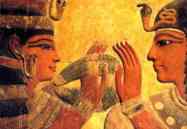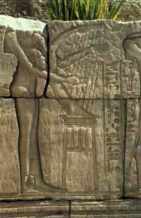MUSIC
AND MUSICIANS OF ANCIENT EGYPT
Doctorate in preparation under the
direction of Professor Jean-Claude
Goyon
University of Lyon II
Lumière
PRESENTATION
OF THE TOPIC
 The
ancient Egyptian sources provide us with a
very broad range of information on the
music and the musicians of this
civilization. They are composed of very
varied documents which come from various
localities and cover all Egyptian history,
from the predynastic time to the
ptolemaïc period. The most
significant part is formed by the
iconographic representations of the tombs
and the temples. The musical scenes which
are depicted there belong either to
everyday life or to religious events.
Besides there are many hieroglyphic
inscriptions, generally short, as one also
finds on papyruses, headstones, statues,
musical instruments, coffins, but also as
a caption of the scenes illustrated on the
walls of the tombs and the temples. We
also have longer texts which were to be
sung and/or to be accompanied by one or
more instruments: " harpist's songs ", "
love poetry " or certain " rituals ".
There are still many items of everyday
life decorated with musical scenes
(spoons, cuts, boxes), like some rare
statuettes, ostraca and amulets
representing the instrumentalists,
sometimes even under the features of
musician animals. They are thus a few
thousands of documents related to the
topic but which are not all of equal
interest. For example, on the few hundreds
of musical instruments preserved in the
museums, the great majority does not carry
any decorative motif and were made at a
late period. Some, nevertheless, date back
to an earlier past and if the sistra, the
cymbals and the clappers were preserved in
greater number, some flutes, harps, lutes,
trumpets and drums also reached us.
The
ancient Egyptian sources provide us with a
very broad range of information on the
music and the musicians of this
civilization. They are composed of very
varied documents which come from various
localities and cover all Egyptian history,
from the predynastic time to the
ptolemaïc period. The most
significant part is formed by the
iconographic representations of the tombs
and the temples. The musical scenes which
are depicted there belong either to
everyday life or to religious events.
Besides there are many hieroglyphic
inscriptions, generally short, as one also
finds on papyruses, headstones, statues,
musical instruments, coffins, but also as
a caption of the scenes illustrated on the
walls of the tombs and the temples. We
also have longer texts which were to be
sung and/or to be accompanied by one or
more instruments: " harpist's songs ", "
love poetry " or certain " rituals ".
There are still many items of everyday
life decorated with musical scenes
(spoons, cuts, boxes), like some rare
statuettes, ostraca and amulets
representing the instrumentalists,
sometimes even under the features of
musician animals. They are thus a few
thousands of documents related to the
topic but which are not all of equal
interest. For example, on the few hundreds
of musical instruments preserved in the
museums, the great majority does not carry
any decorative motif and were made at a
late period. Some, nevertheless, date back
to an earlier past and if the sistra, the
cymbals and the clappers were preserved in
greater number, some flutes, harps, lutes,
trumpets and drums also reached us.
From
the very beginning of the 19th century,
the numerous sources about ancient
Egyptian music aroused the interest of the
scientists. The bibliography on the topic
is impressive. Those who made these
studies are primarily musicologists. The
principal aim of their research was to add
a chapter to the history of music and to
define how the music of Ancient Egypt had
been able to contribute to the genesis of
Western music. They wished, in order to do
this, to rediscover the musical system of
the former Egyptians. In the absence of
musical partitions, the tools for analysis
developed by organology and
ethnomusicology were to enable them to
achieve the goal which they had set. But,
these two sciences have not yet produced
the expected results. They however allowed
us to be more acquainted with the whole of
the musical instruments used by the former
Egyptians.
*
 After
two centuries of publications about music
in ancient Egypt, our intention is to
question the ancient Egyptian sources with
a new approach: that of the social and
cultural history. Indeed, when one looks
at this documentation from this point of
view, many questions arise: what were the
role and the function of music in the
ancient Egyptian society? what kind of
everyday life activities were associated
with this form of artistic expression
(cult, funeral, warfare, hunting, working,
dancing, games, entertainments) and in
which way? Can one define various musical
repertories (sacred music, profane music)?
Were there divinities particularly
associated with music? Who were the male
and female musicians? Did they play a part
in society and did they have a particular
status ? As for those who took part in the
religious ceremonies, were they bound to a
temple or did they move according to the
calendars of the celebrations? Did the
same people play in the religious
festivities and the private banquets? Is
it possible to talk about professional
musicians and establish a hierarchy
between the various titles that we know?
What were their incomes? Was there a
musical training? Who manufactured the
musical instruments? Where did the raw
materials used come from? Was an
instrument dedicated to a specific use
(the repertoire but also the place and
hour of the day)? Were the acoustics of
the temples favorable to sound
demonstrations? Could one hear from
outside the sacred enclosure the ceremony
which was performed inside? Here are as
many questions which have not been tackled
up to now and for which the bibliography
proves almost non-existent.
After
two centuries of publications about music
in ancient Egypt, our intention is to
question the ancient Egyptian sources with
a new approach: that of the social and
cultural history. Indeed, when one looks
at this documentation from this point of
view, many questions arise: what were the
role and the function of music in the
ancient Egyptian society? what kind of
everyday life activities were associated
with this form of artistic expression
(cult, funeral, warfare, hunting, working,
dancing, games, entertainments) and in
which way? Can one define various musical
repertories (sacred music, profane music)?
Were there divinities particularly
associated with music? Who were the male
and female musicians? Did they play a part
in society and did they have a particular
status ? As for those who took part in the
religious ceremonies, were they bound to a
temple or did they move according to the
calendars of the celebrations? Did the
same people play in the religious
festivities and the private banquets? Is
it possible to talk about professional
musicians and establish a hierarchy
between the various titles that we know?
What were their incomes? Was there a
musical training? Who manufactured the
musical instruments? Where did the raw
materials used come from? Was an
instrument dedicated to a specific use
(the repertoire but also the place and
hour of the day)? Were the acoustics of
the temples favorable to sound
demonstrations? Could one hear from
outside the sacred enclosure the ceremony
which was performed inside? Here are as
many questions which have not been tackled
up to now and for which the bibliography
proves almost non-existent.
It
will thus be necessary for us to set out
again from the ancient Egyptian sources.
To begin with, our knowledge of the
Egyptian vocabulary concerning all that
refers to music has to be more precise.
Indeed, the translations suggested up to
now do not account for the great variety
of the Egyptian lexicon. Once the meaning
of each word will be more clearly defined,
we will be able more easily to make the
most of the information given to us by the
hieroglyphic inscriptions. Then, we will
study the musical scenes which decorate
the walls of the tombs and the temples
within the broader framework of the
context to which they are related. That
will lead us to define all the fields
where music intervenes in the ancient
Egyptian society. The classification of
the documentation will then make it
possible to bring closer the scenes which
illustrate the same activities. They will
be able thus to bring light to one another
and to lead us to a better understanding
of the unfolding of a festivity as well as
the moments when music intervenes: texts
recited, sung or chanted according to the
stages of the ceremony, choirs answering
the priest, women dancing on the beat of
the sistres, players of drums preceding
the procession of the divine boat and so
on. Lastly, so as to encompass better the
role, the function and the status of the
male and female musicians in the ancient
Egyptian company, it will be necessary to
analyze their titles, the texts which deal
with them and to make an iconographic
study on their clothes as well as on their
gestures. We know that the Egyptian temple
was an enclosed area and meant for an
elite of priests. It would be thus
interesting to know to which part of the
temple a musician could have access. At
the same time, we would learn which were
the fields where music was allowed and
which were the instruments played with. It
will then be necessary to wonder which
divinity was dedicated to this music as
well as the significance of this
offering.
This
innovative approach of the subject will
bring us new information about an art, a
culture and a society which is several
times thousand-year-old and finally will
allow us to know the role, the importance
and the status of music and the musicians
of ancient Egypt.
Sibylle
Emerit, Lyon, September 1999
|

Sibylle
Emerit, Karnak,
1997
|
|
| Home
|